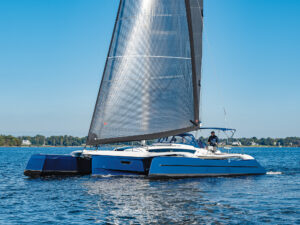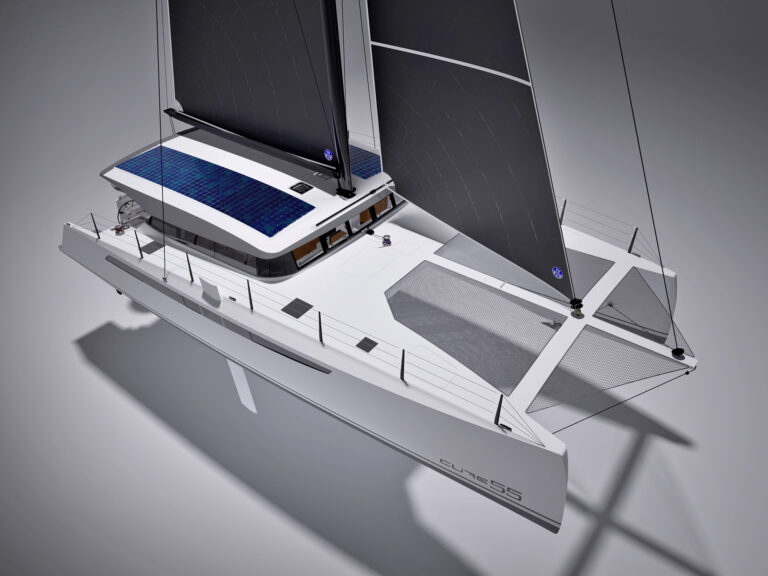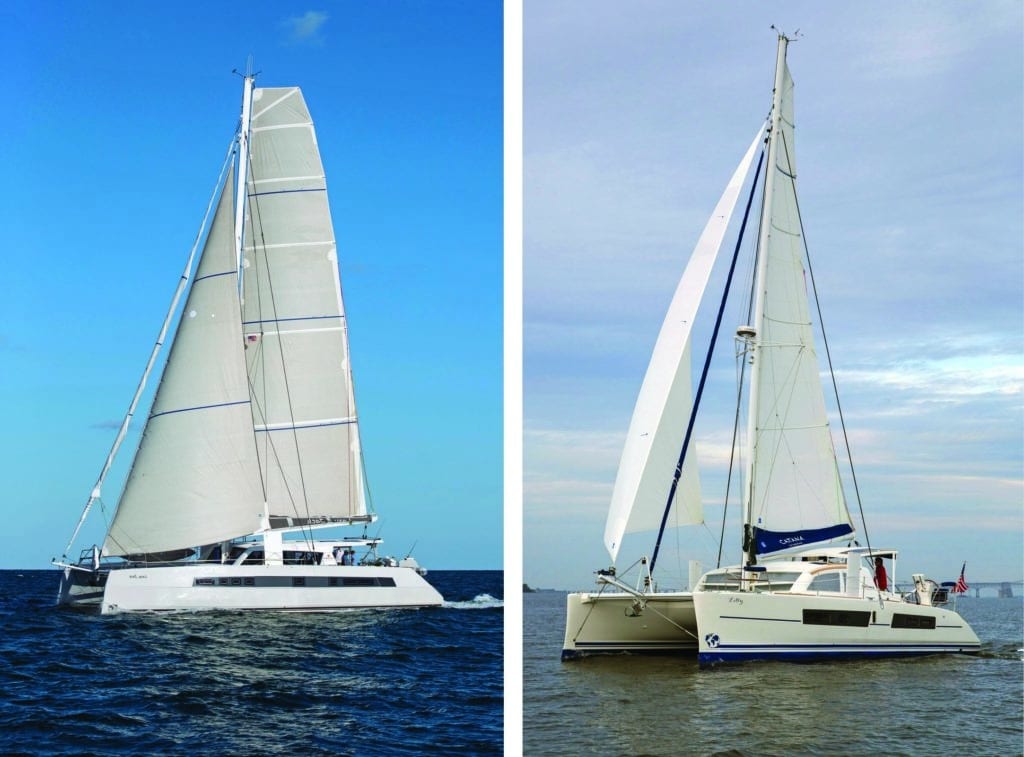
The French catamaran builder Catana introduced two new boats to the U.S. this year: a 42-footer that’s an evolutionary refinement of the existing model lineup, and a totally new 59-foot design that was created by the company’s in-house naval architects and offers a glimpse into the future.
The Catana 42 Carbon made its splash at the U.S. Sailboat Show in Annapolis, Maryland, and stole the hearts of our Boat of the Year Judges because of the quality of the workmanship and its get-up-and-go with the sails hoisted. CW’s Best Midsize Multihull under 50 Feet for 2014 continues the company’s efforts to capitalize on its carbon-fiber infusion capabilities. In terms of sporty good looks, the 42 has much in common with its siblings, including the 47 Carbon and 55 Carbon. It has the same distinctive curves —tulip-shaped bows, asymmetrical hulls that cant outward, sterns that taper to the waterline, and a sleek-looking cabin house that flows upward from just aft of the mast in a sweeping arc concluding with a bimini that partially covers the cockpit. The big difference is the weight that’s shed by using infused carbon fiber and foam in key areas throughout the boat.
Catana 59
The Catana 59, by contrast, takes a radical departure from those curvy forms and presents a new look for the company as it begins its fourth decade of boatbuilding. Let’s start with the tomahawk bows and sharp, angular lines created by a knuckle just above the waterline and a chine just below the sheer that both carry aft to sharp reverse transoms. Besides appearing fast and modern, these design elements allow for hulls with fine entries and narrow profiles below the waterline (for performance), and considerable interior volume (for liveaboard creature comforts). Atop the hulls sits a low-profile house that also bears sharp, straight lines and abrupt angles. The overall result is a head-turner at the dock and on the water.
The 59 we visited in Miami (hull number 4) had been launched in France, sailed to the Caribbean and then north to Miami for last winter’s Strictly Sail show. For the record, the boat looked no worse for wear after an ocean crossing, but that’s what it was built to do. Hulls and deck are cored with Airex closed-cell foam with resin-infused laminates consisting of multidirectional cloth; Twaron fiber is utilized above and below the waterline for collision mitigation and higher tensile strength. The deck is an infused foam and carbon-fiber sandwich as well, as are bulkheads and all major pieces of furniture. Hulls, deck and bulkheads are glued and laminated tocreate essentially a one-piece structure.
The 59 carries a single spreader rig with a high-aspect, flat-topped main; a working genoa set on a furler; and a screacher flown from a Facnor continuous-line flexible furler that is tacked to a short sprit. The design team replaced Catana’s trademark straight daggerboards with curved ones that take up less interior volume; when deployed at 10 knots or more, they act as hydrofoils to float the hulls and reduce drag.
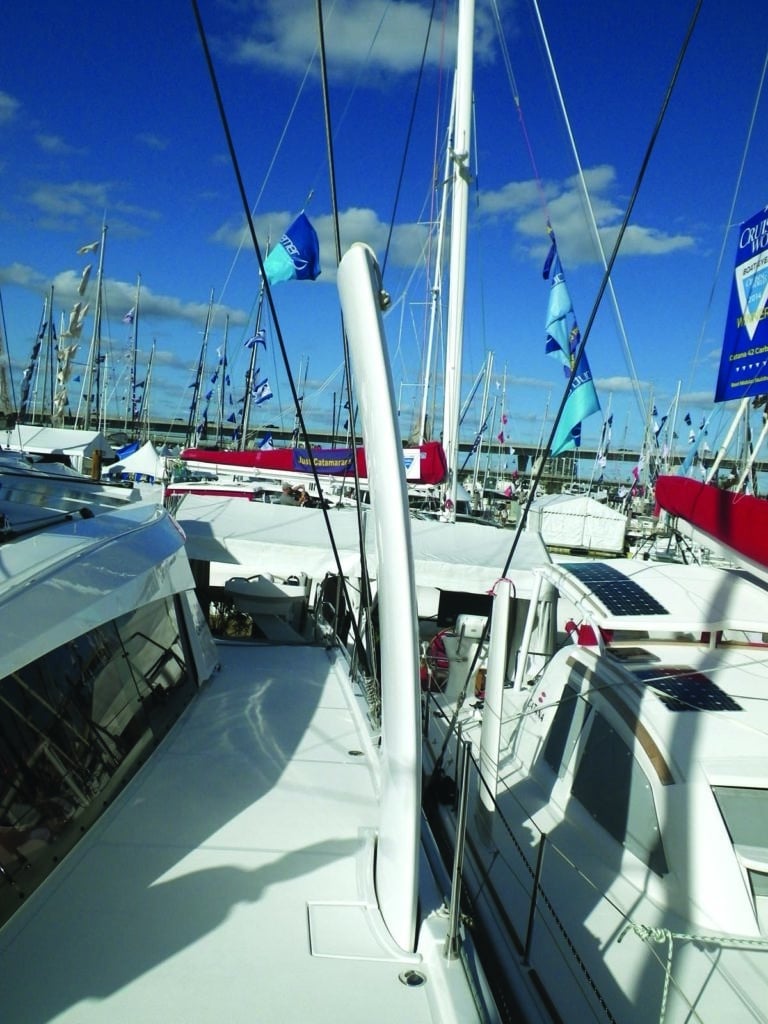
And the boat can sail. Closehauled with the genoa set in about 14 knots of apparent wind, we saw a boat speed of just over 7 knots, not bad considering we had a crowd aboard. Cracked off a little more, we registered speeds of just over 12 knots in 12 knots of true breeze. The owner/captain was aboard for our sail and reported a top speed of about 23 knots on their crossing, adding that they had frequent 240- to 250-nautical-mile days.
For a short daysail, there was a lot going on in the cockpit. The owner, who sails with his wife and a first mate, kept the latter hopping from one side to another to clear winches and tend lines. At sea, with the autopilot set, sailing duties would be more manageable. I really liked the concept of the twin wheels, each set outboard and well aft, and both equipped with engine controls for the twin shaft-driven optional 150-horsepower Volvos.
The pep the 59 displayed underway was equally matched by the comfort Couedel Hugon Design built into the interior. Thanks to a three-part sliding door, the cockpit and saloon can be fully opened up to create an impressive amount of living space. There’s seating and storage everywhere, and a watch-friendly nav station is tucked into the forward port corner of the saloon.
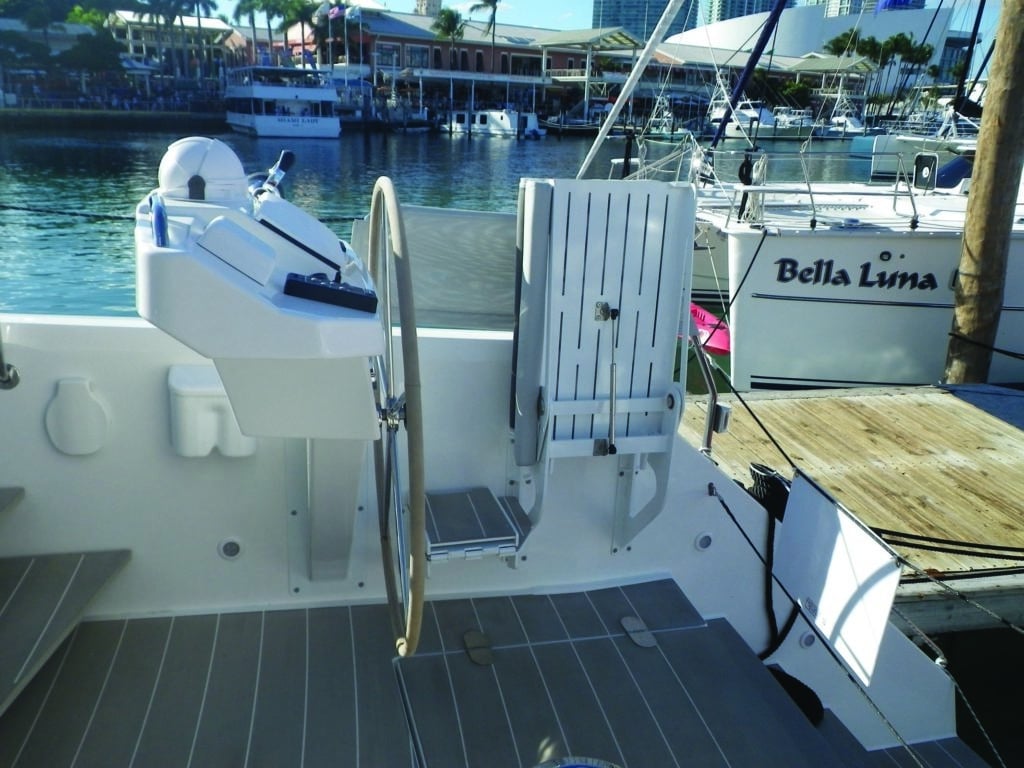
In the cockpit a lounging area sits over a beverage cooler and icemaker to port, with a couch opposite. There are two more fridges in the galley, and a pair of freezers, along with a dishwasher, trash compactor, and four-burner stove and oven. In addition to a genset, the boat has eight 80-watt solar panels mounted on the bimini to power all the gear.
Below, the gray upholstery and white panel color theme extends to the owner’s spacious stateroom to starboard and the guest cabins — two singles aft and a queen forward — to port. A really nice touch is the dark-leather wardrobe lockers found in each.
With a price tag just north of $2.6 million at current exchange rates, the new 59 isn’t a boat for everyone. But for a lucky owner, such as the one we sailed with, it will make a fine platform for seeing the world — exactly what he has planned.
Catana 42 Carbon
If the Catana 59 represents what can be drawn on a broad, expansive, almost limitless canvas, the 42 Carbon shows what is possible within a smaller, tighter frame. Yet, despite the discrepancy in size between the two, the end result is nearly equally impressive. And because the price differential is a couple million bucks (the 42’s tag is $600,000 at current exchange rates), though the slighter boat still isn’t inexpensive, it will appeal to a much wider potential customer base.
In modern boatbuilding, particularly when it comes to displacement — and let’s remember that lighter catamarans are faster ones — less costs more. For companies like Catana, whose clients are generally performance sailors with a serious need for speed, saving weight is an all-encompassing goal, one realized by utilizing exotic materials (like the aforementioned carbon and Twaron) over a more traditional (these days) Airex foam core (which is also used in all of the furniture). Catana employs the resin-infused SCRIMP process in the 42’s laminate, which is a cleaner, highly efficient way to lay up hulls that are structurally substantial without being weighty. The 42 may not look especially different from other cats in its size range, at least not until the sails are set and the former puts the latter in its wake.
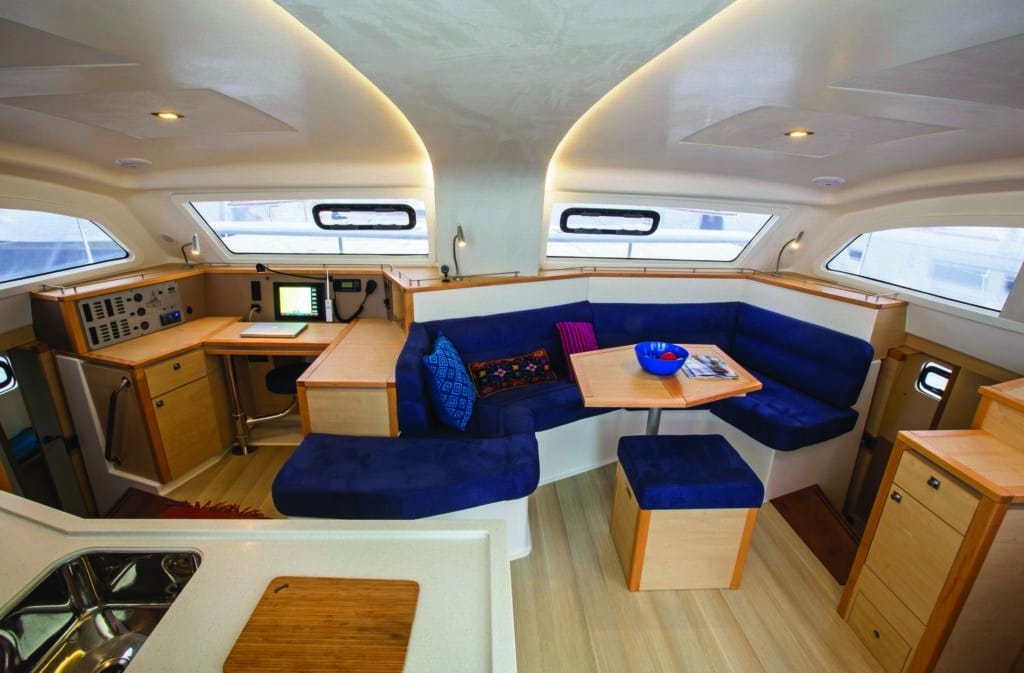
Catana realized it’s fashioning a relative sports car here — not an SUV — and laid out the deck and rig accordingly. The literal centerpiece of the sail-handling system is the hefty pedestal stationed smack-dab at the aft end of the cockpit, upon which is mounted a pair of Harken electric winches above two suites of rope clutches. Sheets, halyards, reef lines and so on are all led here, where a dexterous trimmer can orchestrate practically any maneuver without taking a single step sideways. It’s a smart, nifty setup.
To drive a boat like this, you need to see the road; as with the 59, the wheels are aft and outboard, with wide views in every direction. There’s plenty of grunt in the sail plan, with a hefty square-top mainsail and twin, versatile headsails: a furling jib on the headstay and a furling screecher set off a prominent sprit mounted ahead of the forward cross beam. You need to roll up the screecher to tack it, but that’s a small price to pay for instant, carefree reaching without the hassle of running spinnaker sheets, hauling a kite on deck and so forth.
Continuing the high-tech, performance-oriented theme, the 42 of course sports a set of daggerboards that lower to nearly 9 feet when fully deployed, and will provide plenty of lateral resistance when required upwind. The powerful single-spreader fractional rig is comprised of Diamond rod-rigging and Kevlar cap shrouds. Hang on to your hat before it blows away. There’s a ton of storage on this boat, including a big locker under the cockpit sole and a trio more forward (where the tanks and windlass, in the central one, are also stashed). The wide side decks are promenades. Solar panels are embedded in the sloping coach roof and hard, fixed bimini. There’s a whole lot going on here in 42 feet.
A big sliding-glass door provides entrance to the saloon. There’s a nice forward-facing nav station to port; a dining table and settee to starboard; and an rear-facing galley aft that’s connected to the outdoor living areas through another sliding window. Descend the stairways in the starboard hull to access forward and aft cabins (the latter is larger than the former), which are separated by a storage locker and which share a common head. The port hull houses the owner’s stateroom (for some reason this seemed odd to me; it’s usually on the other side, no?), with a big double aft and a roomy head forward. (A four-cabin layout is also available.)
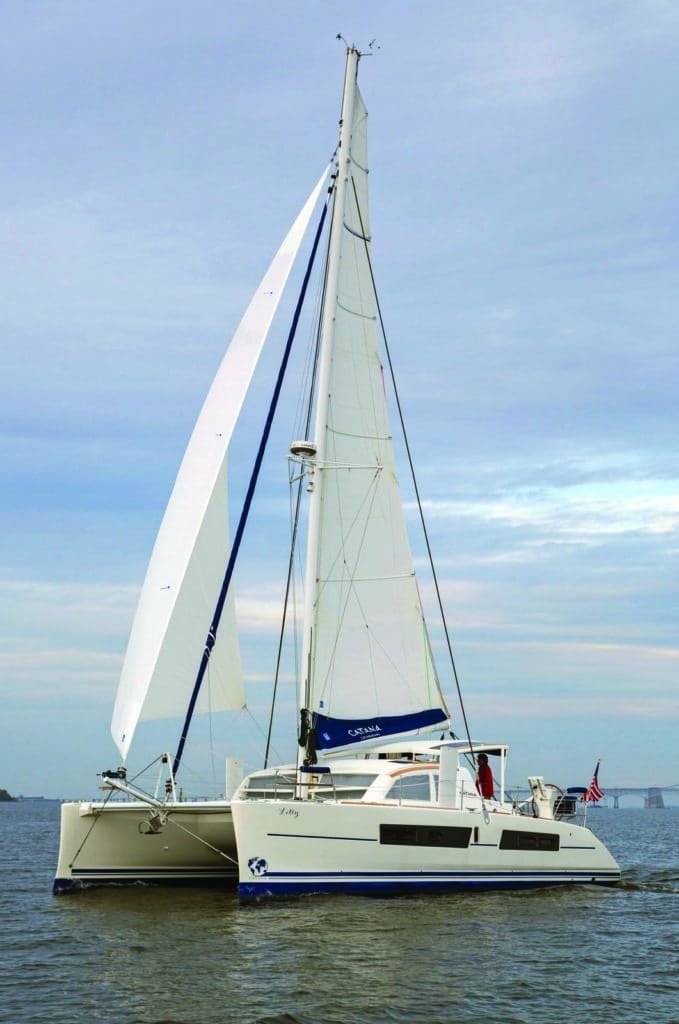
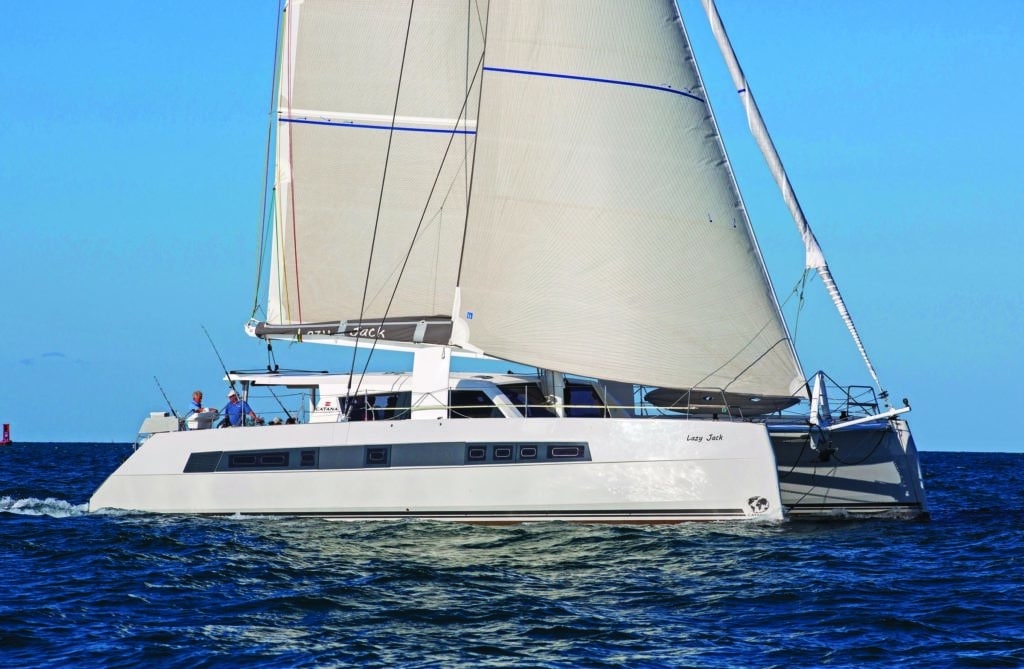
Sadly, we got skunked for breeze the day of our Chesapeake Bay test sail — though in 6 knots of wind, we still eked out 6 knots of close-hauled boat speed — but that did nothing to dissuade us from the notion that this boat will haul the mail. Catana’s been playing with this concept for quite a while now. They got it right a long time ago.
See more boats in the Catana line up here.
Mark Pillsbury and Herb McCormick are CW editors.
This article first appeared in Cruising World, September 2014.


